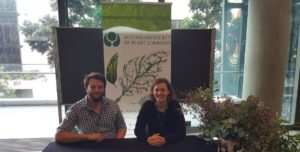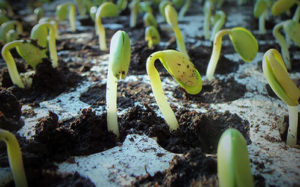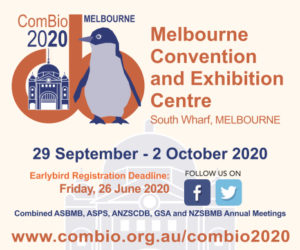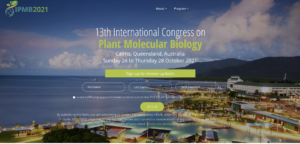Welcome to Phytogen for March 2020. Unfortunately, this year will be remembered as the year our world tackled Covid-19. As we do this over the next few weeks and months, if it helps to alleviate uncertainty you can send me articles that inspire you (georgia.koerber@adelaide.edu.au) and to other members of our communications committee for sharing on Phytogen. Please include some commentary about why they inspire you and if they are in your research area. It would be awesome to receive some material where plants have contributed to solving global problems such as we are facing now, in the past or future.
To start, Chris Cazzonelli from the Hawkesbury Institute, Western Sydney University (WSU) has sent research by WSU and ANU. Click on the link or head to the website: https://phys.org/news/2020-03-darkness-unravel-energy.html. The research has discovered new chemical communication pathways that determine how plants change when they emerge from darkness in the soil to light with implications for their energy generation.
Something I have been amazed to read about is plants being used to create vaccines, as an alternative to chicken eggs; as bioreactors for growing vaccine proteins. The biopharmaceutical company from Canada, Medicago doesn’t work with a live virus, instead the team insert a genetic sequence into a soil bacteria, which is taken up by the plants, which then reportedly begin to produce the protein that can then be used as a vaccine. They soon hope to submit this unique technology for FDA approval. The difference between plants and eggs is “we go directly to producing the vaccine or the antibody without having to propagate the virus” Mr Bruce Clark said, CEO of Medicago.
This year, ASPS has had a new Honorary Secretary Simon Williams from ANU. Below he writes about his research.
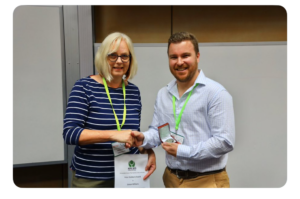
Simon Williams 2019 Peter Goldacre Recipient with ASPS President Kathy Soole at ASPS2019 LaTrobe University.
The structural-basis of plant innate immunity
It is estimated that plant diseases account for up to 15% of crop loses worldwide, presenting a significant economic, environmental and social challenge in a world facing increased demands on food, fibre and biofuels. While the lifestyles of plant pathogens are diverse, a common feature is the use of secreted proteins, collectively known as effectors, which promote pathogen virulence and facilitate disease. During infection plant pathogens can mobilise 10-100s of effector proteins. In response, plants utilise both extracellular and intracellular multi-domain immunity proteins to detect effectors and this recognition leads to disease resistance. The intracellular immunity receptors, known as nucleotide-binding oligomerisation domain-like receptors (NLRs), are arguably the most important plant immunity receptor and can recognise specific effectors to provide protection against potential pathogens. Plant genomes contain hundreds, in some cases thousands, of NLR genes, to ensure maximum protection within their environment. Despite this, resistance is defeated when this repertoire of NLRs can no longer perceive the presence of an effector during the plant-pathogen interaction. We are interested in understanding how NLR proteins perceive effectors and activate disease resistance pathways. To study this, we use a multidisciplinary approach harnessing the power of protein structural biology, biochemistry and biophysics to inform our studies in plants. The Peter Goldacre award recognises the contributions that I have made to understanding how NLR proteins signal via protein-protein oligomerisation through their N-terminal (see papers below). Of course, these achievements were the result of a large team effort and involved numerous national and international collaborators.
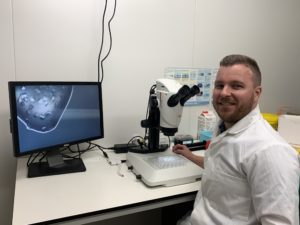
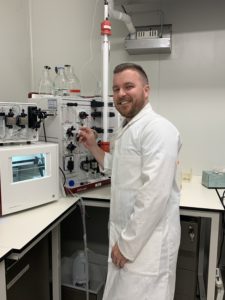
Recently, I started my own laboratory in the Division of Plant Sciences within the Research School of Biology at the Australian National University.
Simon in the lab working with plant proteins.
Our Structural Plant Immunology laboratory seek to understand the molecular-basis of fungal pathogenicity and plant innate immunity. A major focus of our work is the development of methodologies that will enable the engineering of synthetic plant immunity receptors. If successful, we believe these tools and techniques could revolutionise the number of NLR genes available to plant breeders to reduce losses induced by pathogens in instances where resistance does not exist or has been overcome.
I’m excited to take on the role of honorary secretary for ASPS. I joined ASPS at the start of my PhD and have benefited significantly through the collegiality and support that the society provides. I look forward to supporting and promoting the society in my new role.
Williams SJ, Sohn KH, Wan L, Bernoux M, Sarris PF, Segonzac C, Ve T, Ma Y, Saucet SB, Ericsson DJ, Casey LW, Lonhienne T, Winzor DJ, Zhang X, Coerdt A, Parker JE, Dodds PN, Kobe B, Jones JDG (2014). Structural basis for assembly and function of a heterodimeric plant immune receptor. Science, 344: 299-303.
Casey L, Lavrencic P, Bentham AR, Cesari S, Ericsson DJ, Croll T, Turk D, Anderson PA, Mark AE, Dodds PN, Mobli M, Kobe B, Williams SJ (2016). The CC domain structure from the wheat stem rust resistance protein Sr33 challenges paradigms for dimerization in plant NLR proteins. PNAS. 113 (45), 12856-12861.
Zhang X, Bernoux M, Bentham AR†, Newman TE, Ve T, Casey LW, Raaymakers TM, Hu J, Croll TI, Schreiber KJ, Staskawicz BJ, Anderson PA, Sohn KH, Williams SJ, Dodds PN and Kobe B. (2017) Multiple functional self-association interfaces in plant TIR domains. PNAS. 114: E2046-E2052.
Keep these meetings in your calendar: ComBio2020 and IPMB2021
 Keep sending your images to Tam Salter for our ASPS banners.
Keep sending your images to Tam Salter for our ASPS banners.
Please ensure they are .PNG , .jpg, .TIFF, or .pdf, with greater than 300 dpi, email: william.salter@sydney.edu.au
If the images have people, they will have to sign a permission form: ASPSbanner2020
Please print the permission form and have them sign then send along with your image to Tam, we look forward to receiving your images.
